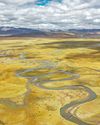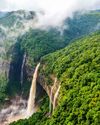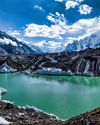
According to local legend, it was none other than the exalted historical figure Alexander the Great (356-323 BCE) who discovered pink salt, otherwise known as Himalayan salt, when he noticed his horses licking the salt on the ground. However, the first records of mining are actually from the 13th century, and Himalayan salt is, in fact, mined from the Punjab region of Pakistan - more than 300 kilometres from the closest point in the Himalayan mountain range.
Formed around 550 million years ago, these lucrative salt deposits are much like any other salt in terms of basic composition. But why exactly is this salt pink? The answer lies mainly in its high iron oxide content, which results in a distinctive rose-coloured hue. Analysis of samples of Himalayan salt has also revealed trace amounts of calcium, iron, copper, zinc, chromium, magnesium, potassium and sulphate, though all at safe levels below one percent.
This story is from the AG 160 edition of ASIAN Geographic.
Start your 7-day Magzter GOLD free trial to access thousands of curated premium stories, and 9,000+ magazines and newspapers.
Already a subscriber ? Sign In
This story is from the AG 160 edition of ASIAN Geographic.
Start your 7-day Magzter GOLD free trial to access thousands of curated premium stories, and 9,000+ magazines and newspapers.
Already a subscriber? Sign In

The Mighty Yellow
Over 5,000 kilometres long and flowing through nine provinces and autonomous regions, the Yellow River is China's second largest, after the Yangtze, while its basin is deemed the cradle of Chinese civilisation

Wildlife Big Yellow Beauty
The popular "amelanistic" form of the Burmese python is considered among the most beautiful snakes - if that's your sort of thing

All That Glitters Is Gold
From Turkey to China, the yellow metal plays a central role in cultural practices and is coveted as a symbol of affluence and status

Chengdu Hotel Spotlight TRIKA TSANG INTERNATIONAL HOTEL
For an authentic taste of Tibet in the heart of Chengdu, the most luxurious option is the majestic Trika Tsang International Hotel.

Conservation Yellow in Peril
While the demand for use in traditional Chinese medicine is putting seahorses under pressure, it is damaging non-selective fishing that is driving depletion

Revealed Doctor Yellow
Japan Railways' special lemony Shinkansen is a rare sight to behold

History Spiritual Rebirth
During the Spanish Golden Age, Portuguese explorer Ferdinand Magellan achieved the first European navigation to Asia via the Pacific, arriving in the Philippines in 1521 and claiming the islands for Spain. But by converting the first Filipinos to Catholicism, Magellan also instigated the Christianisation of the entire archipelago, a spiritual rebirth celebrated through the two most important festivals in the Philippines - Fiesta Señor and Sinulog.

Green Dreams
With its tea plantations and rice paddies, dense jungles and expansive forests, the region is well known as a green paradise. But many of the most impressive Asian landscapes have names you may never have heard of. Journey with us as we reveal just some of the incredible locations that make the rest of the world green with envy!

Life On The Edge
In the Chukotka Autonomous Okrug, in the remote northern Russian Far East, indigenous ethnic groups like the Chukchi and the Yupik live in the most extreme conditions, hunting seals in their traditional kayaks as they have for millennia

The Karakoram Anomaly Decoded
For decades, scientists have believed that glaciers in the Karakoram Range are defying the trend of those across the globe-resisting glacial melt due to human-induced global warming. But as we trek up the Karakoram's second-longest glacier in July, as the United Nations announces the world's hottest ever month on record, does the melting ice beneath our feet suggest the so-called Karakoram Anomaly is slowing? Or is there a ray of hope it will continue to delay the inevitable?